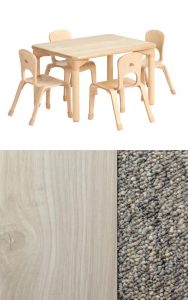Simon Sinek, best-selling author and renowned lecturer, made his mark with a famous TED Talk encouraging leaders and organizations to “Start with Why.” Knowing “what” you do and “how” you do it does not matter if you don’t know “why” you’re doing it. As we embark on a new journey for Greensboro Montessori School through 70 in 70: The Fund for GMS, we’re excited to examine Mr. Sinek’s model of what, how and why as it relates to revitalizing our Primary classrooms. This exploration provides transparency, meaning and context … all of which are necessary to effectively educate our children and be responsible stewards of our donors’ contributions.

An example of the table and chairs, wood-grain tile and carpet selected for our Primary classrooms should we raise $70,000 by December 31, 2017.
What: One of the main goals of 70 in 70: The Fund for GMS is to revitalize our Primary classroom environments. “Revitalize” can be ambiguous, so let’s unpack this concept. If we raise $70,000 in 70 days, all four Primary classrooms will receive:
- New tables, chairs and shelving made from durable, sustainably harvested solid-wood and featuring a contemporary yet comfortable aesthetic specifically designed with the 3- to 6-year-old at heart
- New flooring including bonded, cushioned carpet and resilient, wood-grain vinyl tiling
- New countertops at every sink and snack station
- An enhanced outdoor classroom, with the addition of an outdoor sink and chalkboard to the Primary garden
In addition to the Primary classroom revitalization, we will also award faculty grants to the professional educators in our other divisions: Toddler, Lower ELementary, Upper Elementary and Junior High. This democratic school process includes a committee of students, faculty, and administration who review and approve grant requests from faculty. Grants focus on specific needs that will propel a classroom's or division's curriculum to the next level.
How: It’s simple - not easy - but simple. By raising $70,000 by December 31, 2017, we will have the funding to support this immediately actionable, strategic imperative for our School, the Primary classroom revitalization. $70,000 also supports our powerful tradition of awarding faculty grants.
Why: The environments in which we live, work and play directly influence the levels of joy, productivity and success we experience in each of these endeavors. Think about the time and effort we, as adults, place in building warm, pleasant and efficient environments for ourselves, our families and guests. The spaces we design impart value on the people who spent time in them.
The same goes for a child’s classroom. While we may take this for granted, Maria Montessori revolutionized education by designing her classroom environments for her students, not for the teachers. Furthermore, she trained teachers in classroom design so they could create environments that optimize student learning. But why?
Students require freedom of movement in their living and learning spaces. Classrooms must have child-sized small tables for group work, tables for a single student to work independently, and chairs that can easily be moved by the student. Students are able to make themselves comfortable and find their place in the room where they best work.
Classroom furniture also facilitates learning attention to detail, control of error, and self-regulation. Students receive lessons on how to carry chairs safely; how to walk in a controlled manner carefully navigating friends and materials laid out on rugs; and how to learn when a work or space is not available in a specific moment. Carrying a chair without dropping it, knocking a friend, or disturbing a group is a challenge to be repeated for success. And is all done by design.
Another key element in a Montessori classroom is the consideration of aesthetics: beauty and simplicity are what draw the child’s interest into the purposeful work available throughout the classroom. Each and every day, our teachers prepare their learning environment by arranging materials on the shelves in an order and sequence that facilitates their use. Our teachers’ goal is to connect their students to the materials, which then become the active “teacher” of abstract concepts giving the student opportunities for discovery-based learning.
In describing the importance of the teaching-role played by the materials in the classroom, Dr. Montessori wrote: “As a teacher, the material is always ready, always patient, constant in mood, and prepared to repeat its lesson. It is truly a striking teacher in that it imparts a deep mastery, constantly leading to analysis and discovery until the root of the problem is reached. The pupil will never again forget that lesson.”
An investment in our students’ learning environment is an investment in them. Upon crossing the threshold of their rejuvenated classrooms for the first time, our Primary students will know they are valuable members of our community. The improved aesthetics of their classrooms will instill a greater sense of purpose, clarity, motivation, ownership and belonging in each of them, and their learning will be maximized.
At face value, flooring, furniture and countertops may not seem important or inspirational. But when we know why design and beauty play a leading a role in the Montessori classroom, we understand the significance of our investment. (We also see how Montessori’s classroom design remains on the cutting edge of education.) Just like gathering places of our adult lives - living rooms, kitchens, offices, conference rooms, even that special corner at your local coffee shop - prepare us for our best work, so do our classrooms for our children.


